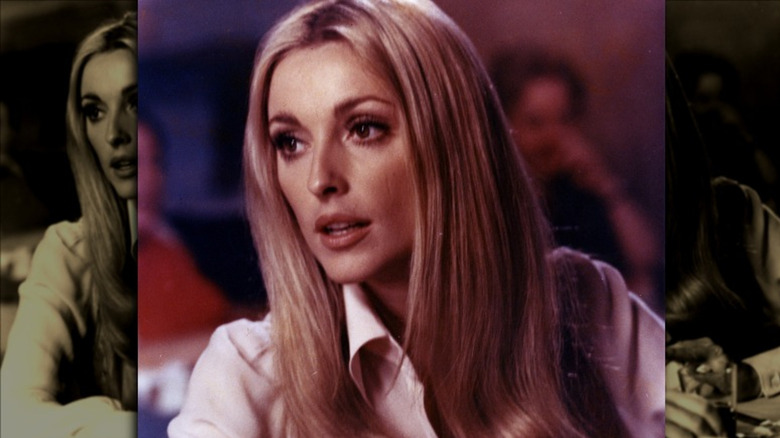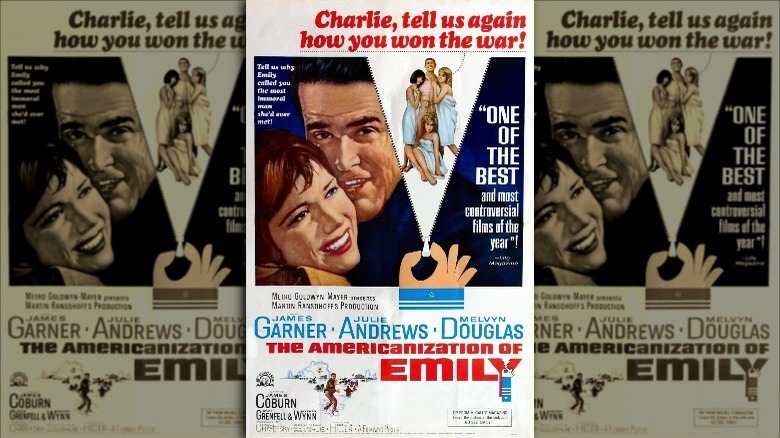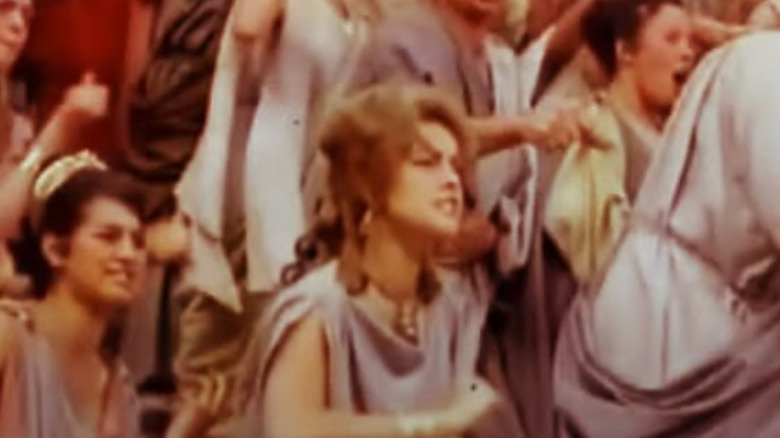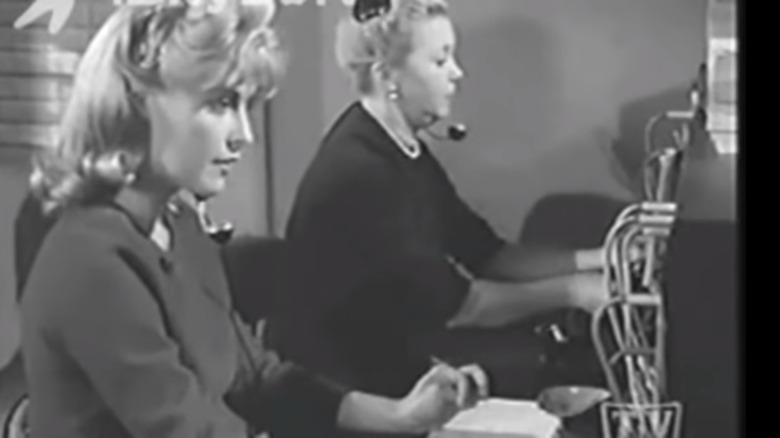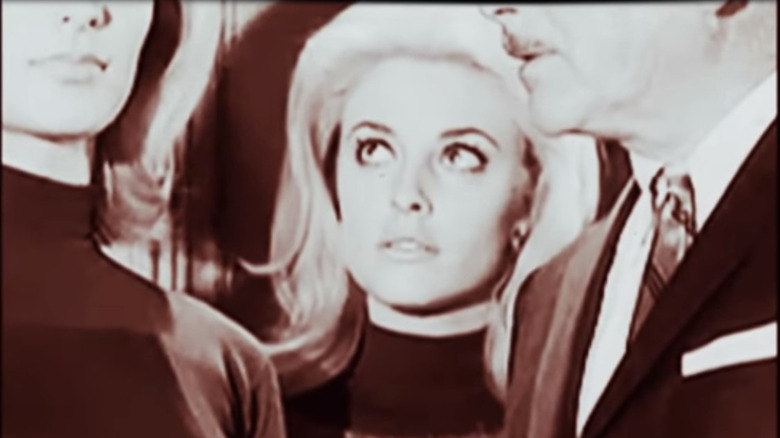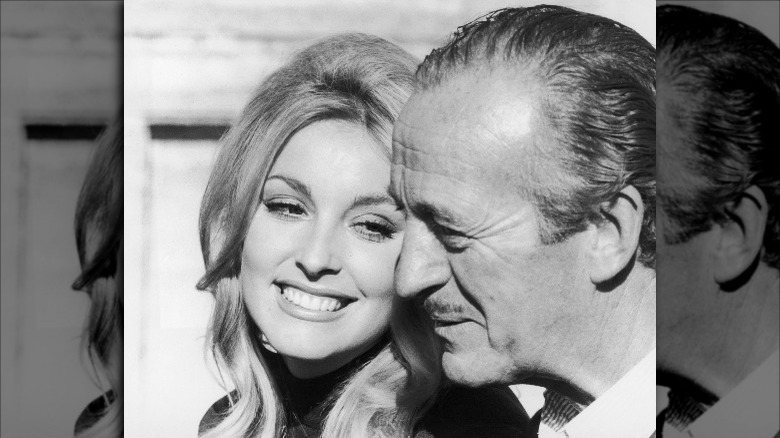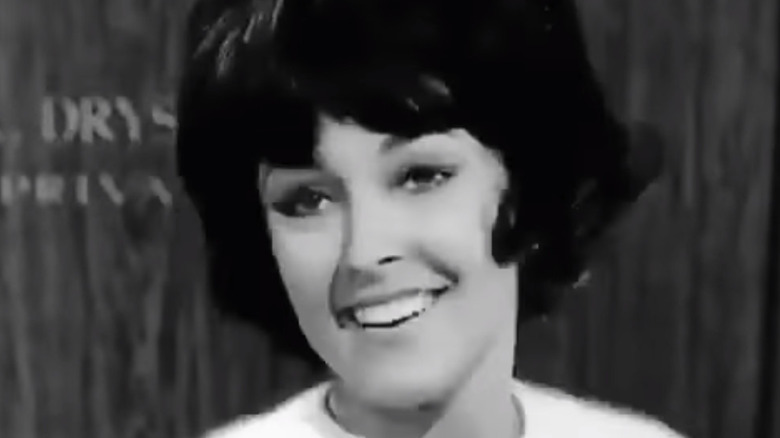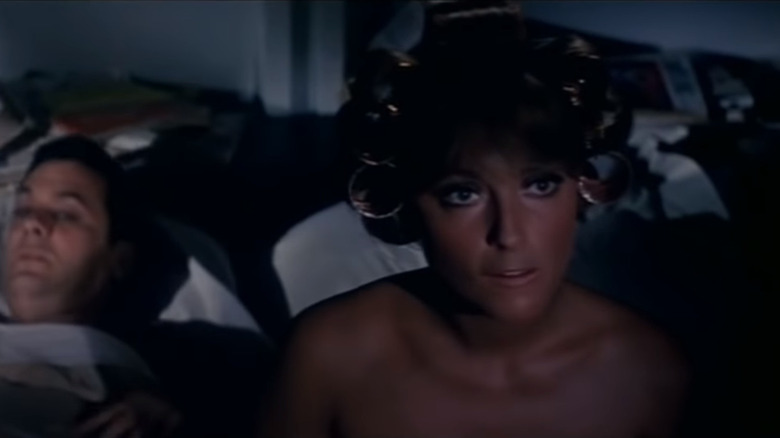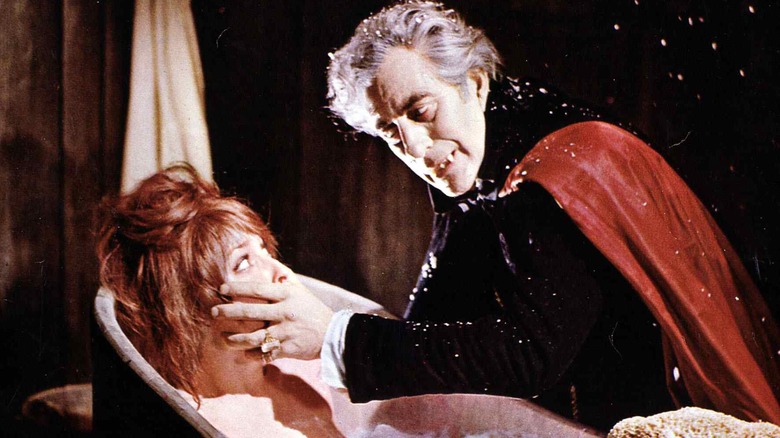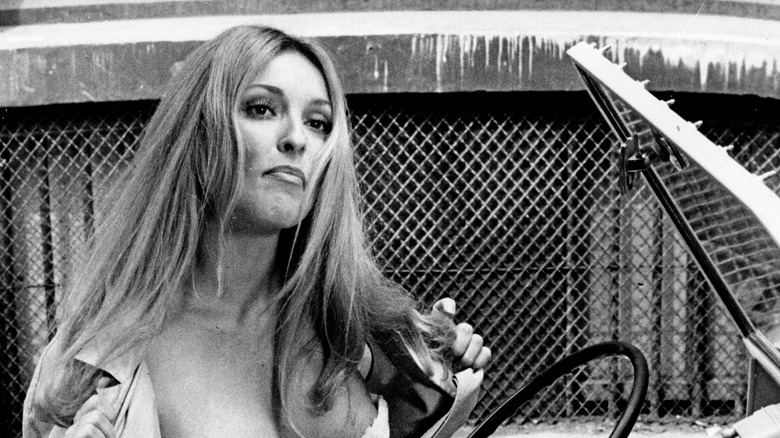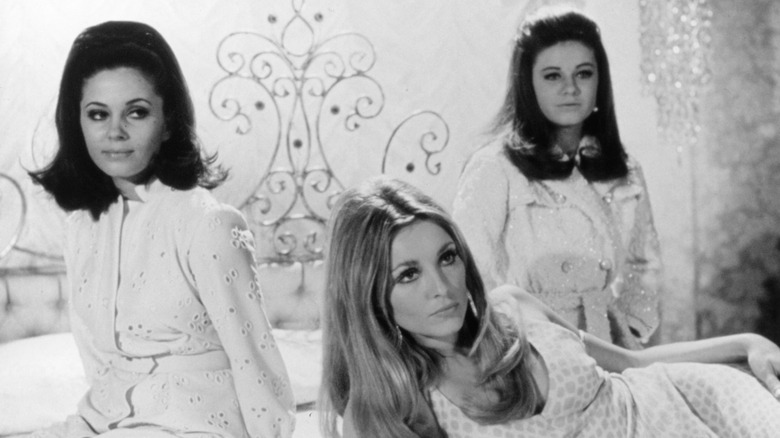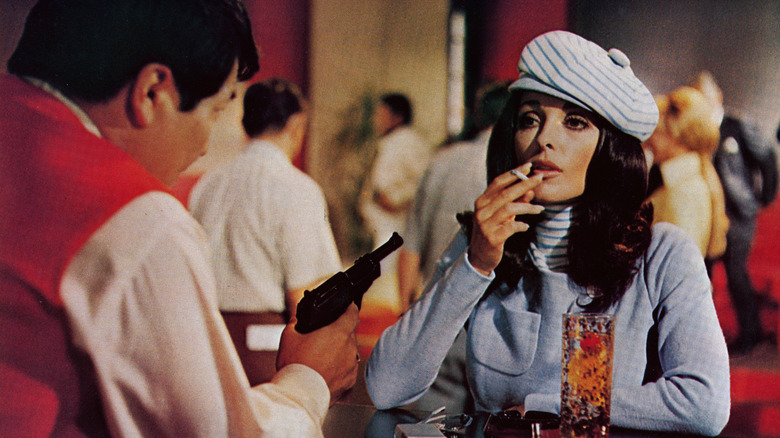Sharon Tate's Onscreen Performances Ranked Worst To Best
Chances are you know exactly one thing about Sharon Tate: How she died. Her incredibly tragic death at the hands of Charles Manson's deranged followers in 1969 — when she was more than eight months pregnant — has come to define her. Which is a tragedy, not just because Tate had great potential as an actress. After years of being a fashion icon and a celebrity, Tate showed every sign of being on the verge of a breakout in Hollywood.
Of course, whether Tate would have gone on to be a celebrated actress is speculation because audiences were collectively robbed of her future. However, she was married to Roman Polanski years before his downfall, when he was still a major power player in Hollywood. So it's safe to assume she would have had plenty of access to premier roles and would have had every chance to prove herself.
Whether she would have risen to the challenge or not, the relatively small number of performances she left behind are available evaluate her progress and her artistry. Here are Sharon Tate's onscreen performances ranked worst to best.
"The Wheeler Dealers," 1963, and "The Americanization of Emily," 1964
These two films default to the bottom of any list of Sharon Tate's performances for one simple reason: There's no surviving footage of her to judge, and there's very little information about her performances. By 1963, Tate had landed an agent, Harold Gefsky, and caught the attention of producer Martin Ransohoff, who signed Tate to a seven-year contract.
According to Texas Monthly, Tate appeared in "The Wheeler Dealers," which starred James Garner and Lee Remick. In "Sharon Tate: A Life," author Ed Sanders reports that her involvement was noted by columnist Leonard Lyons in the New York Post. Tate's work on the film was likely cut, but, as explained by the Guardian, what's significant is that Ransohoff had been extremely protective of Tate's image, careful not to overexpose her or put her in roles until she was ready. Tate herself said, "Mr. Ransohoff didn't want the audience to see me till I was ready." Her appearance in "The Wheeler Dealers" is therefore a sign of her acting progress.
Tate then worked on "The Americanization of Emily," a 1964 film starring Julie Andrews, in which she played "Beautiful Girl." Similarly to "The Wheeler Dealers," the fact that Ransohoff was putting Tate out there in movies meant he thought she had the potential to succeed.
Patrician in Arena in "Barabbas," 1961
According to author Greg King, the young Sharon Tate lived in Verona, Italy, where her father, an Army officer, was stationed. As a teenager, she and some friends stumbled upon a movie shoot and ended up as extras. American movie companies often filmed in the area, recruiting extras from the nearby army base, and Tate put her name in for any more extra work that came up.
In 1961, when Tate was 18, the production team for "Barabbas," starring Anthony Quinn and Jack Palance, came to town. A biblical epic telling the story of Barabbas, the man whose freedom is offered by Pontius Pilate alongside Jesus in the Bible, the film includes scenes that required a large number of extras in the age before digital crowds. Tate and two friends were selected to appear in some of these crowd scenes.
Although it was a tiny, non-speaking role, Tate's work in "Barabbas" is significant because it impressed star Jack Palance. Seeing something in Tate, he talked to her about acting and offered advice on how she might manage an acting career. He then took the unusual step of arranging for her to travel to Rome to have a film test done. The test didn't directly result in any work, but the experience encouraged Tate to pursue a life on screen.
Telephone Operator and Girl, "Mister Ed," 1963
If you're not familiar with "Mister Ed," it was a deeply silly sitcom about a talking horse named Mister Ed. It aired from 1961 to 1966, and, as reported by Television's New Frontier, gave Sharon Tate her television debut in the 1963 season 4 episode, "Ed Discovers America." Producer Martin Ransohoff got her the role to give her some experience. She's officially credited simply as "Girl," and her performance consists of making out with two different men and then being almost unrecognizable in period costume, but it was a start.
Ransohoff brought Tate back to "Mister Ed" eight episodes later in "Love Thy New Neighbor," and he must have been impressed enough with her appearance to expand her role: in this episode, Tate has dialogue. She plays straight woman to Allan Lane's talking horse in a brief bit where Mister Ed tries to start a conversation and says some relatively sexist things to a harried telephone operator. These are very minor roles, so it's difficult to extrapolate much about her abilities. But everyone has to start somewhere, and Tate looks great, seems comfortable on camera, and demonstrates an ability for comedy.
Therapist in "The Man from U.N.C.L.E," 1965
By 1964, James Bond had inspired a full-on fad for suave secret agents, and "The Man from U.N.C.L.E." was one of the TV shows to cash in on the craze. It starred Robert Vaughn and David McCallum as American and Russian agents working for a secret international intelligence and law enforcement agency.
In 1965, Sharon Tate appeared in the episode "The Girls of Nazarone Affair," credited as "Therapist." She's one of four women who use a secret serum to gain incredible strength. It's a small role, and as Preppies of the Apocalypse notes, her main function is to run about looking good. But it's significant because it's Tate's first significant screen time. She's in plenty of scenes, and, as noted in "Film Fatales: Women in Espionage," she got to show off her physical acting skills. The role required her and co-star Kathy Kersh to fight with Vaughn, and she and Kersh worked extensively with Vaughn to choreograph and plan out the scene. It also served as a lesson for Tate in Hollywood politics, as Vaughn was apparently fairly condescending to her and Kersh, prompting Tate to surprise him with a fight move, which in turn caused the crew to erupt into laughter and proved that Tate was tough enough for the business.
Odile de Caray in "Eye of the Devil," 1966
In 1966, producer Martin Ransohoff cast Sharon Tate in a small but pivotal role in the horror film "Eye of the Devil." As Odile de Caray, Tate was supposed to make her big screen debut playing a witch living on an ancient French estate owned by David Niven and Deborah Kerr. The Lineup explains that the film was plagued by production problems that had nothing to do with Tate: Original lead actress Kim Novak was injured, and Kerr replaced her and had to re-shoot most of her scenes. The writer left, and no fewer than three directors worked on the film.
This was Tate's first major role, and her performance is ... strange. Let's Play Something Else described it as "If monotone speech patterns, flat line emotions and physical beauty were requisite for the part, then she nailed it." In "Sharon Tate and the Manson Murders," author Greg King reports that a review in the New York Times described her performance as "chillingly beautiful but expressionless."
The performance is expressionless, but this also seems to be a deliberate choice for the character, who is meant to be supernaturally ominous. For a first major role, Tate achieved what she needed to: She proved she could do more than stand around and look pretty.
Janet Trego in "The Beverly Hillbillies," 1963–1965
If you want to watch an actress literally learn her craft in front of you, watch Sharon Tate's appearances in "The Beverly Hillbillies." According to Fame Focus, Tate appeared in 15 episodes of the seminal comedy about a family of poor hillbillies who discover oil on their property and move to Beverly Hills, where hilarity ensues.
Producer Martin Ransohoff once again got Tate the role. She first appeared in the fourth episode of the second season, "Elly Starts to School," playing a student named Mary. It was a disaster. As author Greg King explains, her performance was judged to be very "amateurish ... it was hard for her to read a line."
Rasnohoff leaped into action, signing Tate up for speech and acting classes, and insisting she apply new discipline to rehearsing her lines and working on her craft. And it paid off. When Tate returned to the show later, she had a regular role in a brunette wig as bank teller Janet Trego. This role gave Tate invaluable experience, and it also demonstrated that she could not only perform — she becomes increasingly confident and funny over her 13-episode run — but that she could take criticism and do the work. In the end, that work paid off, because this was the role that convinced Hollywood that she was good enough to take a chance on.
Malibu in "Don't Make Waves," 1967
"Don't Make Waves" is an odd film, based on the novel "Muscle Beach" by Ira Wallach. Tony Curtis plays a middle-aged man who arrives in hippie-central California and pursues a much younger surfer and skydiver (yes, really) named Malibu, played by Sharon Tate. It's not exactly a comedy and not exactly a drama. The Motion Pictures points out that Malibu is a pretty shallow role — Tate's main job is to look beautiful. According to author Ed Sanders, Tate was only paid $750 a week for her work on the $4 million film, but, as author Greg King notes, this was Tate's breakout role. The marketing campaign heavily featured Tate in a bikini, there was a product tie-in with Coppertone tanning lotion that also featured Tate, and photos of her in skydiving gear were even mailed out to all branches of the Parachute Club of America.
Considering her limited role (and her low opinion of the film, which she described as "a terrible movie"), Tate does a good job and received good reviews for her performance — critic Leonard Maltin singled out her "funny performance." She's relaxed and funny in the role, and more importantly she impressed everyone involved with her work ethic and attitude, which convinced other directors to cast her.
Sarah Shagal in "The Fearless Vampire Killers," 1967
"The Fearless Vampire Killers" is a horror-comedy by Roman Polanski, whose brilliance as a filmmaker has long been overshadowed by the sexual assault that drove him out of the United States for good in 1978. According to an article in Film Comment, Martin Ransohoff bought the U.S. distribution rights to the film and radically edited it for domestic audiences, much to Polanksi's dismay, but in both cuts of the film, Sharon Tate stands out. This is easily her first truly good performance.
Deep Focus Reviews says that Tate has a "incandescent quality" in the film, conveying a joy and innocence that works well for her character, who is the love interest for Polanski and victim of the local vampire. In a film that somehow combines silly slapstick humor with some really chilling imagery, they also note the "extratextuality" of her performance — she implies a lot of depth for the character that isn't in the script, using facial expressions and body language to rise above what could have been another role where she was just pretty scenery.
Tate is one reason the film has endured as a cult movie. Bottom Shelf Movies calls her performance "radiant and beguiling" and notes that no other actress could have played the role, which is entirely down to Tate because the role as written could have been played by almost anybody.
Pat in "The Thirteen Chairs," 1969
Also known as "12 + 1," this was the last film Sharon Tate worked on. She was pregnant during filming and in later scenes had to resort to tricks to hide her growing bump. This was also the film that best shows what Tate could have been had she lived past 26. It's a perfect match of weird, oddball comedy and Tate's own sensibilities. Based on the 1928 novel "The Twelve Chairs," by Ilya Ilf and Evgeny Petrov (which would be adapted again just a year later by Mel Brooks), the story concerns an Italian barber named Mario who travels to England when his wealthy aunt dies, only to find his inheritance is just 13 antique chairs. He sells them, then learns that a fortune in jewels is hidden inside one. He doesn't know which one, however, so he teams up with an antiques dealer played by Tate to track down each of the chairs.
Classic Movie Favorites says that Tate's performance showed "real promise," and Derek Winnert reports that co-star Terry-Thomas offered the ultimate compliment by saying she was "entirely natural before the camera." Tate is very good in this, handling the physical comedy and leaning into the absurdity of the film as she and Mario go to ridiculous lengths to track down and retrieve the chairs. It is obvious that this should have been the kind of film Tate pursued throughout the rest of her career because she had a real talent for comedy.
Jennifer North in "Valley of the Dolls," 1967
This was the film that firmly established Sharon Tate as an actress. The movie isn't great — Roger Ebert said "the story is so confused that we can hardly keep straight just who has done what, but it doesn't matter" — but, as reported by NewNowNext, Tate stood out and was nominated for a Golden Globe for her performance.
The role of Jennifer North was custom-made for Tate. Vanity Fair explains that North is "a ravishing actress and sex symbol who's insecure about her talent and being perceived as only 'a body,'" which means Tate arrived on set well-prepared for the role. But that doesn't mean there was no acting required — AnOther says that Tate steals every scene she's in with her very presence, and Variety called Tate's performance "particularly good."
Considering how famously bad the film is, the fact that Tate's performance could shine through is very telling. She finds a real sadness and sense of injustice in a character who exists solely for the melodramatic end she meets — and even in that end Tate captivates, looking glamorously despairing as she takes a bottle of pills and drifts away.
Freya Carlson in "The Wrecking Crew," 1968
There's a reason Quentin Tarantino focused on "The Wrecking Crew" when portraying Sharon Tate in his film "Once Upon a Time in Hollywood": It's hands-down her best performance.
"The Wrecking Crew" was the fourth and final film starring Dean Martin as secret agent Matt Helm. Vanyaland explains that Martin was in an indifferent phase of his career, and that the films aren't highly regarded even as mildly funny parodies of James Bond. Alternate Ending sums it up pretty well, calling "The Wrecking Crew" "charmless and witless."
But the clumsy, frustrated Freya Carlson turns out to be the role Sharon Tate was born to play. She's easily the best thing in the film, and really the only reason anyone talks about this movie or bothers to watch it today. She's got great comic timing here and performs some excellent fight choreography (she really did train with Bruce Lee). Vanyaland recognizes her "transcendent lightness," and Alternate Ending nails why it all works: Tate takes her role seriously even if none of the other actors (especially the lead) do and despite the film being generally terrible.
If you had any doubt that Sharon Tate had what it takes to be a big star in Hollywood, watch her scenes in "The Wrecking Crew." They'll change your mind.
